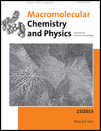Photopolymerizable Monomer Miniemulsions: Why Does Droplet Size Matter?
Florent Jasinski
Laboratory of Photochemistry and Macromolecular Engineering, ENSCMu, University of Haute-Alsace, 3 Rue Alfred Werner, 68093 Mulhouse Cedex, France
Search for more papers by this authorEmeline Lobry
Laboratory of Photochemistry and Macromolecular Engineering, ENSCMu, University of Haute-Alsace, 3 Rue Alfred Werner, 68093 Mulhouse Cedex, France
Search for more papers by this authorCorresponding Author
Abraham Chemtob
Laboratory of Photochemistry and Macromolecular Engineering, ENSCMu, University of Haute-Alsace, 3 Rue Alfred Werner, 68093 Mulhouse Cedex, France
Laboratory of Photochemistry and Macromolecular Engineering, ENSCMu, University of Haute-Alsace, 3 Rue Alfred Werner, 68093 Mulhouse Cedex, France.Search for more papers by this authorCéline Croutxé-Barghorn
Laboratory of Photochemistry and Macromolecular Engineering, ENSCMu, University of Haute-Alsace, 3 Rue Alfred Werner, 68093 Mulhouse Cedex, France
Search for more papers by this authorAdrien Criqui
Mäder Research - MÄDER GROUP, 130 Rue de la Mer Rouge, 68200 Mulhouse, France
Search for more papers by this authorFlorent Jasinski
Laboratory of Photochemistry and Macromolecular Engineering, ENSCMu, University of Haute-Alsace, 3 Rue Alfred Werner, 68093 Mulhouse Cedex, France
Search for more papers by this authorEmeline Lobry
Laboratory of Photochemistry and Macromolecular Engineering, ENSCMu, University of Haute-Alsace, 3 Rue Alfred Werner, 68093 Mulhouse Cedex, France
Search for more papers by this authorCorresponding Author
Abraham Chemtob
Laboratory of Photochemistry and Macromolecular Engineering, ENSCMu, University of Haute-Alsace, 3 Rue Alfred Werner, 68093 Mulhouse Cedex, France
Laboratory of Photochemistry and Macromolecular Engineering, ENSCMu, University of Haute-Alsace, 3 Rue Alfred Werner, 68093 Mulhouse Cedex, France.Search for more papers by this authorCéline Croutxé-Barghorn
Laboratory of Photochemistry and Macromolecular Engineering, ENSCMu, University of Haute-Alsace, 3 Rue Alfred Werner, 68093 Mulhouse Cedex, France
Search for more papers by this authorAdrien Criqui
Mäder Research - MÄDER GROUP, 130 Rue de la Mer Rouge, 68200 Mulhouse, France
Search for more papers by this authorAbstract
In monomer miniemulsions, droplet size is a key parameter impacting the optical properties, and consequently their photopolymerizability under UV light. Three simple spectrophotometric methodologies are developed, based on an integrating sphere, to evaluate precisely the effect of droplet size on radiation absorption and scattering, which both contribute to light attenuation. Using a series of diluted acrylate monomer miniemulsions ranging from 40 to 300 nm, all the methods converge toward a constant absorption coefficient, comparable with that in solution. In contrast, a droplet-size decrease causes a significant and progressive reduction of the scattering coefficient, with a positive effect on light penetration.
Supporting Information
As a service to our authors and readers, this journal provides supporting information supplied by the authors. Such materials are peer reviewed and may be re-organized for online delivery, but are not copy-edited or typeset. Technical support issues arising from supporting information (other than missing files) should be addressed to the authors.
| Filename | Description |
|---|---|
| macp_201300278_sm_suppl.pdf188.8 KB | suppl |
Please note: The publisher is not responsible for the content or functionality of any supporting information supplied by the authors. Any queries (other than missing content) should be directed to the corresponding author for the article.
References
- 1 T. C. Bond, R. W. Bergstrom, Aerosol Sci. Technol. 2005, 39, 1.
- 2 A. Bricaud, A. Morel, Appl. Opt. 1986, 25, 571.
- 3
V. V. Tuchin,
Tissue Optics: Light Scattering Methods and Instruments for Medical Diagnosis, 2nd ed., SPIE,
Bellingham, WA, USA
2007.
10.1117/3.684093 Google Scholar
- 4 W. Chantrapornchai, F. M. Clydesdale, D. J. McClements, J. Food Sci. 2001, 66, 464.
- 5 W. Chantrapornchai, F. Clydesdale, D. J. McClements, J. Colloid Interface Sci. 1999, 218, 324.
- 6 B. Herzog, K. Quass, E. Schmidt, S. Müller, H. Luther, J. Colloid Interface Sci. 2004, 276, 354.
- 7 N. J. Turro, M.-F. Chow, C.-J. Chung, C.-H. Tung, J. Am. Chem. Soc. 1980, 102, 7391.
- 8 I. Capek, Polym. J. 1996, 28, 400.
- 9 K. Jain, J. Klier, A. B. Scranton, Polymer 2005, 46, 11273.
- 10 C. Schauber, G. Riess, Makromol. Chem. 1989, 190, 725.
- 11 I. Capek, Des. Monomers Polym. 2012, 15, 345.
- 12 A. Chemtob, B. Kunstler, C. Croutxe-Barghorn, S. Fouchard, Colloid Polym. Sci. 2010, 288, 579.
- 13 P. A. Hoijemberg, A. Chemtob, J. Poly, C. Croutxé-Barghorn, A. M. Braun, Macromolecules 2011, 44, 8727.
- 14 J. Dou, Q. Zhang, L. Jian, J. Gu, Colloid Polym. Sci. 2010, 288, 1751.
- 15 A. V. Fuchs, G. D. Will, Polymer 2010, 51, 2119.
- 16 J. Tonnar, E. Pouget, P. Lacroix-Desmazes, B. Boutevin, Macromol. Symp. 2009, 281, 20.
- 17 P. A. Hoijemberg, A. Chemtob, C. Croutxé-Barghorn, Macromol. Chem. Phys. 2011, 212, 2417.
- 18 V. Daniloska, T. Radmila, J. M. Asua, Chem. Eng. J. 2012, 184, 308.
- 19 J. M. Asua, Prog. Polym. Sci. 2002, 27, 1283.
- 20 J. Ugelstad, M. S. El-Aasser, J. W. Vanderhoff, J. Polym. Sci., Polym. Lett. Ed. 1973, 11, 503.
- 21 L. Huang, Y. Li, J. Yang, Z. Zeng, Y. Chen, Polymer 2009, 50, 4325.
- 22 T. Scherzer, J. Polym. Sci., Part A: Polym. Chem. 2004, 42, 894.
- 23 H. Wang, H. R. Brown, Macromol. Rapid Commun. 2004, 25, 1095.
- 24 L. Sun, J. R. Bolton, J. Phys. Chem. 1996, 100, 4127.
- 25 P. B. Zetterlund, T. Nakamura, M. Okubo, Macromolecules 2007, 40, 8663.
- 26 A standardized statistic giving a measure of the “goodness of fit” is R2 bonded by 0 and 1. For all the miniemulsions, a value of R2 greater than 0.95 was obtained.
- 27 The range 200–250 nm is discarded as it presents signal saturation because of the strong absorption of acrylates in this domain.





